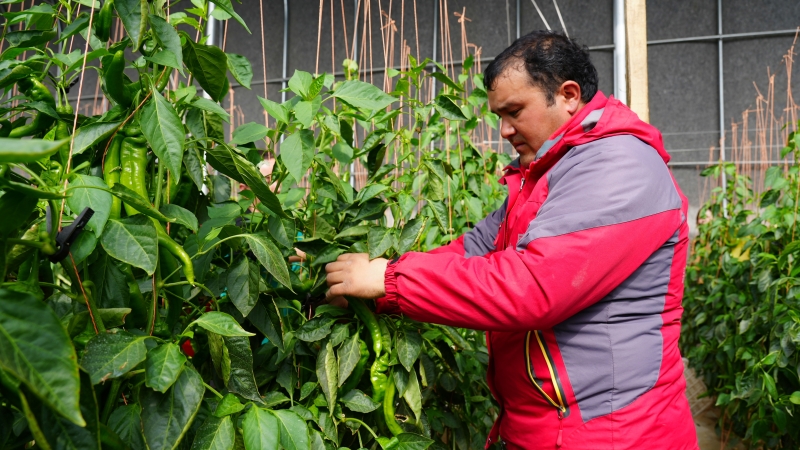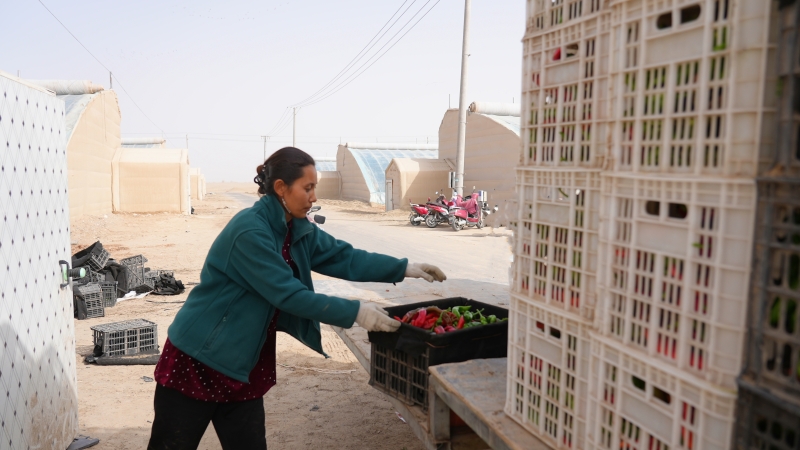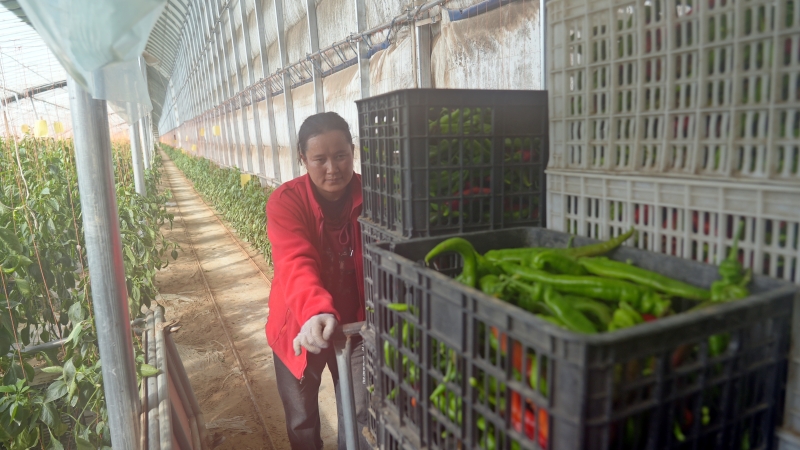On February 28, 2024, basking in the warm sunshine of the spring day, the journalists arrived at the vegetable base of Xinjiang Shengshi Huaqiang Agriculture Technology Co., Ltd., located in the new economic area of Hetian County, Hotan Prefecture, northwest China's Xinjiang Uygur Autonomous Region. Greenhouses were neatly arranged, and inside, workers were skillfully harvesting ripe tomatoes, peppers, cucumbers, and other vegetables amidst thriving plants. Outside the greenhouses, vehicles from surrounding county and city agricultural wholesale markets loaded with fresh produce streamed out of the vegetable base.

Photo shows Song Zongke, production technology director of Xinjiang Shengshi Huaqiang Agriculture Technology Co., Ltd., explains the planting techniques to a worker at the vegetable base of Xinjiang Shengshi Huaqiang Agriculture Technology Co., Ltd. in the new economic area of Hetian County, Hotan Prefecture, northwest China's Xinjiang Uygur Autonomous Region. (Photo by Hu Lizheng)
It is the rapid development of modern agriculture that has brought about this bountiful scene here. Xinjiang Shengshi Huaqiang Agriculture Technology Co., Ltd. adheres to the principle of "protecting arable farmland and seeking benefits from the Gobi and desert." In 2019, the company built 998 greenhouses in thousands of mu of desert, creating an oasis in the desert and turning the Gobi into fertile fields. And the greenhouses have become a "treasure trove" for local people to increase their income and get a well-off life.
"The screw pepper that is being harvested now is considered to be one of the best varieties in Xinjiang, with a high market demand. It is a 'bestseller’ among vegetable vendors," said Song Zongke, director of production technology at Xinjiang Shengshi Huaqiang Agriculture Technology Co., Ltd.

Photo shows a staff member operates equipment at the vegetable base of Xinjiang Shengshi Huaqiang Agriculture Technology Co., Ltd. in the new economic area of Hetian County, Hotan Prefecture, northwest China's Xinjiang Uygur Autonomous Region. (Photo by Hu Lizheng)
In 2023, with the support of smart agriculture and intelligent devices, the company produced 70,000 tons of high-quality fruits and vegetables, with a total output value of 240 million yuan (about 33.34 million U.S. dollars). Truckloads of tomatoes, cucumbers, and peppers are heading to various places in Xinjiang from here, weaving into a high-quality fruits and vegetables supply chain. In this way, the local planting structure has been effectively adjusted, industrial development has been promoted, and farmers’ income has also been improved. Song Shuaining, operator of Xinjiang Shengshi Huaqiang Agricultural Technology Co., Ltd., told reporters, "With 80 percent of the fruit and vegetables produced at the base already ordered, growers have no worries about sales, and everyone is excited about farming."

Photo shows a staff member transports the freshly picked pepper to the sales point, northwest China's Xinjiang Uygur Autonomous Region. (Photo by Hu Lizheng)
In greenhouse No. 127 of the vegetable base, reporters met Abduhelil Ujiabdulla, the production team leader of Xinjiang Shengshi Huaqiang Agriculture Technology Co., Ltd., who was using an app on his mobile phone to control a curtain machine that helps maintain a constant temperature inside the greenhouse. "After more than a year of work, I've learned the planting techniques for peppers and tomatoes, and now I earn over 6,000 yuan a month," he said. "Smart farming has brought me benefits. In the future, I will study these planting techniques more diligently to earn more money and improve my family's life."

Photo shows a staff member picks peppers at the vegetable base of Xinjiang Shengshi Huaqiang Agriculture Technology Co., Ltd. in the new economic area of Hetian County, Hotan Prefecture, northwest China's Xinjiang Uygur Autonomous Region. (Photo by Hu Lizheng)
What high-tech methods are hidden in these greenhouses? Song Zongke revealed, "The most important ones are the sand-free cultivation technology and the integrated water and fertilizer management technology. Sand-free cultivation is perfect for desert and barren areas because it doesn't require good soil conditions and allows for continuous cropping and a shorter planting cycle. The integrated water and fertilizer management technology is even more advanced. With a mobile app, one person can control 20 hectares of greenhouses, ensuring precise irrigation and fertilization. This leads to efficient water and fertilizer use, increased nutrient utilization, and reduced pests and diseases."

Photo shows a staff member puts baskets of peppers onto a truck in northwest China's Xinjiang Uygur Autonomous Region. (Photo by Hu Lizheng)
With modern technology, Xinjiang Shengshi Huaqiang Agricultural Technology Co., Ltd. has created a new planting management model that integrates unified seedling cultivation, water and fertilizer management, plant protection, temperature control, and sales. Local farmers have been actively learning plant management techniques at the base, planting distinctive crops in greenhouses and embarking on the road to shared prosperity.
Xinjiang Shengshi Huaqiang Agricultural Technology Co., Ltd. nowadays is not just a vegetable base, but also a comprehensive agricultural industrial park integrating agricultural planting, popular science displays, tourism sightseeing, parent-child picking, and cold chain transportation.

Photo shows a staff member transports freshly picked peppers out of the greenhouse at the vegetable base of Xinjiang Shengshi Huaqiang Agriculture Technology Co., Ltd. in the new economic area of Hetian County, Hotan Prefecture, northwest China's Xinjiang Uygur Autonomous Region. (Photo by Hu Lizheng)
"This year, we plan to continue to increase investment, expand the planting scale from the current 666.67 hectares to 1666.67 hectares, and increase the production of fruit and vegetable from 70,000 tons to 150,000 tons. We also aim to sell our high-quality agricultural products to the BRI participating countries," said Song Shuaining.
According to the Bureau of Agriculture and Rural Affairs of Hotan Prefecture, by 2023, the area of facility agriculture planting in Hotan Prefecture has reached 1760 hectares, with a total production of 163,000 tons of greenhouse fruits and vegetables. The rapid development of facility agriculture has not only enriched the public's vegetable supply but also increased farmers' income.
According to Du Linhui, director of the Horticultural Specialty Department of the Agricultural Technology Extension Center of Hotan Prefecture, Hotan Prefecture will focus on promoting technology research and application, establishing demonstration bases and promotion platforms, and collaborating with international advanced agricultural technology institutions and enterprises. Advanced digital intelligent equipment and technology will be introduced to further improve agricultural quality and efficiency, and enable the modernization, intelligence, and digitization of the agricultural industry to empower rural revitalization.
(The Media Convergence Center of Hotan Prefecture, Reporters: Hu Lizheng, Ablikim)









